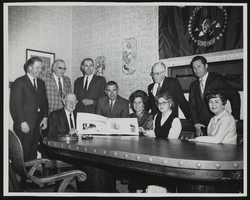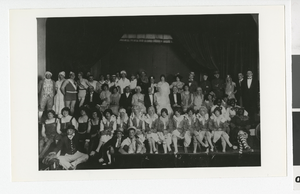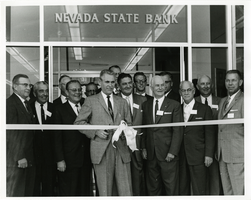Search the Special Collections and Archives Portal
Search Results

Report from U.S. Geological Survey on pottery
Date
1912
Archival Collection
Description
This folder is from "Maps and Assorted Documents" file of the Sadie and Hampton George Papers (MS-00434)
Text

Correspondence, Levi Syphus to Sadie George
Date
1924-08
Archival Collection
Description
This folder is from the "Correspondence" file of the Sadie and Hampton George Papers (MS-00434)
Text

Correspondence, Levi Syphus to Mr. A. E. Green and Mr. David Naylor Jr.
Date
1926-02-11
Archival Collection
Description
This folder is from the "Correspondence" file of the Sadie and Hampton George Papers (MS-00434)
Text

Film strip of Boulder City or Hoover Dam construction, image 006: photographic print
Date
1934-05-29
Archival Collection
Description
This photograph has three images. The first one (0272_0026) is a picture of the first bucket of concrete poured in Boulder Dam, June 6, 1933. The handwritten inscription reads, "The first bucket was 'grout' (cement and water) which was spread over surface of pour with steel brooms. All loose rocks have been pried out, and all cracks have been pumped with grout until filled. Some has taken a week of continuously pumping night and day. Each from and pour is supervised by government selected men." The second one (0272_0027) reads, "Excavation for foundation three hundred feet below river bed down to bedrock." The picture is looking upstream, excavation for dam foundation, Boulder Dam photo provided by the Bureau of Reclamation. It also says, "Seen from lookout point above. Trucks struggling up and down the steep grade, reminds you of ants as they attack this giant job. I often wondered where did they put all this dirt and rubble? Brakes were soon worn out and never replaced. Trucks were geared down real low, but you still got a thrill, going downhill. x-marks trussel for rail that will bring concrete from lower mixing plant around the bend where the mts. end in a gentle slope." written as a handwritten inscription. The third one (0272_0028) reads, "Drilling of walls to clean up and to blast off loose slabs on upstream canyon walls. These men climb hand over hand at end of shift, and slide down to work. The art of keeping your balance in a bos'n chair is picked up in a hurry at heights like this. I saw a miner hand a 90 lb. Hammer of his shoulder and climb hand over hand 75 ft. up, until he got past the overhang before he could touch the canyon wall with his feet. It was a side show," written as a handwritten inscription.
Image

Film strip of individuals or Hoover Dam construction, image 006: photographic print
Date
1930 (year approximate) to 1939 (year approximate)
Archival Collection
Description
This photograph has three images. The first one (0272_0040) reads, "Early morning on grave-yard shift, day shift coming on, notice lunch boxes. Hardway Johnnie (John Armitage) the graveyard Asst. Super. Coming down to see why they are slow getting to their jobs - that's me right behind him." "The men nicknamed me Hardway Jr. I relayed his orders. He had a hard time walking those 2x12 boards on top of the forms - they did install rails later, as you can see, but didn't weather the rough treatment - (xx) elevator shaft." "I got a lot of learning under John Armitage. He sent me to relieve on so many different jobs. Had clean up crew for three months - also I ran the pours with #5 hi-line until it could reach the dam no more, with the angle it sat. Tied steel on intake towers two nights." "Most fearful job was relief hook tender on the stiffleg. The job was situated on a pad on the upstream face of the dam, about level with the low-mix trusel, with just enough room for two of the 8 yd. buckets - the stiffleg would leave a bucket of mud - pick an empty one - No.6 hi-line would leave and empty one and pick up the empty. The men stood as flat as they could - during the exchange with the bucket down. The men would grab the swinging steel cables in one hand, the 12 pound hook that felt like 50 pounds. Place cable on eye in bucket, then twist hook down and slam in place - no guard rails." The second one (0272_0041) reads "Intake towers growing. The bottom of the picture shows a finished pour - it must cure for 12 hours in the hot weather, and 48 hours, cold weather - 300 ft. down if you step off the end of this panel (see arrow)," as a handwritten inscription. The third one (0272_0042) reads "The morning after my first night of work, with Dickey" (dog).
Image

Film strip of Boulder City or Hoover Dam construction, image 009: photographic print
Date
1930 (year approximate) to 1939 (year approximate)
Archival Collection
Description
This photograph has three images. The first one (0272_0043) has a handwritten inscription that reads, "Government hi-line setting 30' pipe on tracks in working tunnel. Note size of men." The second one (0272_0044) reads, "Placing pipe in penstock tunnels. Spider stays in place until next pipe is connected - still on the rails." The third image (0272_0045 and 0040) gives a good view of workmen getting these two locations ready to pour. It reads, "The carpenters leveling the panels and installing the vertical keys - plumbers installing cooling pipe - clean-up crew with their air and water hose sandblasting top of cement for better bonding. Must be a rush job for grave-yard tonite." "Form raisers, with 'A' frames in place. Prying the specially made panel, to replace it with regular one you see lying in pour below." "Gov. inspectors. They check every form of work that is done on the dam. Then sign the OK to pour. My job, once, was to see that all works were OK." "I liked the carefree and daring of the form raisers. Also had a friend in the crew. I got a lot of ribbing from them about my easy job. After two weeks of trying I at last got a transfer. Later felt Tommy sorry. But could walk the 2x12 with both shoulders slung with chain jacks and block & tackle. Or drop down on a up-stream panel, hook my safety belt and twist out as many 'she-bolts' as the best." "It was fearful hanging on your safety belt, on the upstream face of the dam. Out of sight, all you could see was a lot of down - hang on for dear life - when the crew starts prying the panel loose and you & panel are swinging on the jacks - loved it."
Image

Film strip of Boulder City or Hoover Dam construction, image 017: photographic print
Date
1930 (year approximate) to 1939 (year approximate)
Archival Collection
Description
This photograph has three images. The first one (0272_0084) reads, "Top of dam about one form wide - everyone getting in each other's way" (duplicate of Image 0272_0016). The second image (0272_0085) reads, "Getting higher and more enormous. Can you see what's swinging on end of No.7 line?" Refers to the arrow at the top right of photo. "(3) tunnels drilled for penstocks that divert water to turbines. So much to tell about, that's shown in this pic. You can see where the turbines will set. The (slot) in middle of dam indicates how much of the dam has been cooled. Notice how dam curves into canyon walls - to brace against weight that will build up behind it." The third image (0272_0086) shows an early view of the enormous amount of excavating being done and tailings to be moved. An inscription reads "Pouring cement on any part of the dam has not begun, only the diversion tunnels and tracks for head tower and tail tower that hi-lines across the channel are connected to" (referring to the arrow at top of photo). The inscription continues "(x) Reeve fell down this tunnel but was cemented at that time. On the dam I never heard anyone being hurt with falling rock. But - most injuries and fatalities occurred building roads to the dam and at the location of dam. No men have been covered up and left in the cement. Nothing but the purest cement went into the construction of dam, maybe a piece of metal if it wasn't oily. About men being buried in the dam is a misconception (sic). Some have been covered up with cement when the bucked dumped out of control, but the men were rushed to first aid and washed off, and treated, but very few injuries."
Image

Park Commission meets with Governor Paul Laxalt and presents him with Valley of Fire Master Plan. Standing from left to right: Bill Wood, Assistant Administrator Nevada Park System; Elmo de Ricco, Director Department of Conservation; Eve Cronkhite, State Parks Administrator; Chris Sheering, Nevada State Park Advisory Commission, and Bob Forson. Seated (from left to right): Colonel Tom Miller, Chairman; Governor Paul Laxalt; Thalia Dondero; Jean Ford, and Audrey Harris: photographic print
Date
1969 (year approximate) to 1970 (year approximate)
Archival Collection
Description
From the Jean Ford Photograph Collection (PH-00295) -- Standing, from left to right: Bill Wood, Assistant Administrator Nevada Park System; Elmo de Ricco, Director Department of Conservation; Eve Cronkhite, State Parks Administrator; Chris Sheering, Nevada State Park Advisory Commission; Bob Forson. Seated, from left to right: Colonel Tom Miller, Chairman; Governor Paul Laxalt; Thalia Dondero; Jean Ford; Audrey Harris
Image

Photograph of Kiwanis Follies, Las Vegas (Nev.), April 30-May 1, 1928
Date
1928-04-30
1928-05-01
Archival Collection
Description
Kiwanis Follies members in a high school auditorium. This photograph was taken either April 30, 1928, or May 1, 1928. Photographed by the Myrtle M. Colaw Production Co. Depicted within the photograph are: Wally Rhoades, N,R, Burkhart, Gene Ward, Earl Farrar, Carl Trelease, Frank Diveney, Bill Davis, Glen Jarrit, Jim Downs, Sam Herman, Paris Stewart, Howard McMullen, Kendal Nungesser, Earl Davidson, Harley Harmon, Don Bremner, Geo. Hardman, W.J. Flowers, Bert Williams, Dr. Smith, Bill Fulton, Bill Schott, Bud Durkins, Doc Bullette, Parson Sloan, Doc Dixon, Tom Carrol, J.H. Down, Dean Bingham, Doc Myers, Doc Conger, Lestlie Edwards, Jack Pembroke, Cal Barnum, Ira Earl, Bill Johnson, Harry Anderson, A.S.Tract, Harve Perry, Hern Krause, Rosie Ward, John Mc Donald, Hal Buzick, Cub Ryerce, "Art" Harrington, Bus Squires, Harold Brinley, John Graglia, Earl Barr, Chas. ""Ted"" Rae, Dusty Rhoades, Dick Roschl, Bill Woodard, Steve Whitehead, Roscoe Thomas, Joh Miller, Vince C
Image

Photograph of Mayor Oran K. Gragson cutting the ribbon at the opening of Nevada State Bank, Las Vegas, Nevada, circa 1960s
Date
1960 to 1969
Archival Collection
Description
Las Vegas Mayor Oran K. Gragson cutting the ribbon at the opening of Nevada State Bank. The white-haired gentlemen standing to his left is former Nevada Governor Vail Pittman. Oran Kenneth Gragson (February 14, 1911 – October 7, 2002) was an American businessman and politician. He was the longest-serving mayor of Las Vegas, Nevada, from 1959 to 1975. Gragson, a member of the Republican Party, was a small business owner who was elected Mayor on a reform platform against police corruption and for equal opportunity for people of all socio-economic and racial categories. Gragson died in a Las Vegas hospice on October 7, 2002, at the age of 91. The Oran K. Gragson Elementary School located at 555 N. Honolulu Street, Las Vegas, NV 89110 was named in his honor. Vail Montgomery Pittman (September 17, 1880[a] – January 29, 1964) was an American politician. He was the 19th Governor of Nevada. He was a member of the Democratic Party. Pittman moved to Tonopah, Nevada in 1904 and began a successful newspaper publishing career. He met Ida Louise Brewington there and they married in Reno, Nevada on May 20, 1919. He and his wife bought the "Ely Daily Times" in Ely, Nevada and moved there in April of 1920 and began what was to be a very successful business. Elected to the Nevada State Senate, Pittman was in the position from 1925 to 1928. Pittman was elected the 19th Lieutenant Governor of Nevada in 1942. He was a candidate in the Democratic primary for United States Senate in 1944, but was defeated by the incumbent, Pat McCarran. He became governor when Edward P. Carville resigned in 1945. He was elected in 1946 to a term of his own and Pittman served until 1951. He and his wife moved back to Ely and continued operating the "Ely Daily Times" and traveling extensively. He served as a member of the 1960 Democratic National Committee.
Image
Pagination
Refine my results
Content Type
Creator or Contributor
Subject
Archival Collection
Digital Project
Resource Type
Year
Material Type
Place
Language
Records Classification
